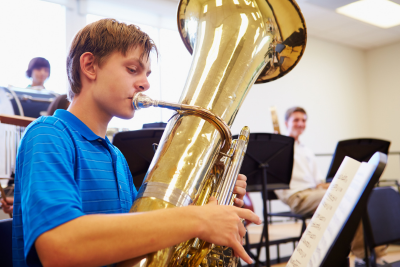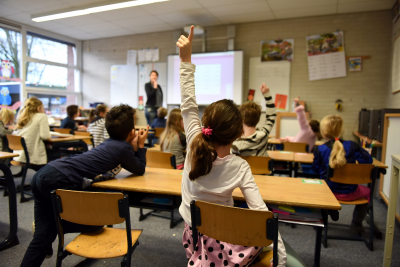School Climate and Connectedness
What is the connection between youth substance use, mental health, and school?
A positive school environment where students feel a sense of connection and belonging is vital for academic success and overall well being. A person’s experience at school greatly influences their mental health and adolescent risk behaviors, including substance use.
What is School Connectedness?
School connectedness reflects the students’ belief that peers and adults support, value, and care about them as individuals, in addition to their academic success. Schools that foster an environment of belonging and inclusion create protective factors that help students to grow in the classroom and beyond.

Research has shown that when youth feel connected to their schools this is associated with:
- Better mental health (lower reports of anxiety and depression)
- Lower sexual health risks
- Less likely to use substances
- Lower risk of encountering or participating in violence
- Likelihood of engaging in healthy behaviors, such as physical activity, healthy eating, and prosocial activities
- Higher grades and test scores
- Better school attendance and likelihood to graduate high school
School connectedness is strongly correlated with positive youth development and should be a priority when schools are planning professional development and developing policies and practices.
Staff who dedicate their time, interest, attention and emotional support show students they are cared for as individuals in addition to their academic achievement.


By building opportunities for students to participate in prosocial activities and build social connections, schools can help students develop positive peer groups and improve overall perceptions of the school environment. Examples of these opportunities include: group learning activities such as class projects where students can share their unique interests and strengths, and school-sponsored extracurricular activities. Special attention should be given to encourage, and motivate youth most in need of prosocial connections to join and be part of these opportunities.
Youth need support and encouragement from the adults in their lives. In order for students to be engaged and committed to their own learning, they have to believe that their school is invested in their growth and success.


The physical environment and psychosocial climate can set the stage for positive student perceptions of school.
A protective factor can be defined as “a characteristic at the biological, psychological, family, or community (including peers and culture) level that is associated with a lower likelihood of problem outcomes or that reduces the negative impact of a risk factor on problem outcomes.” [Source]
Schools can boost protective factors and increase student engagement by providing:
- Positive teacher expectations & effective classroom management
- Positive partnering between school and family
- School policies and practices and policies to reduce bullying
- Presence of mentors and support for development of skills and interests (connectedness to adults outside family)
- Opportunities for engagement within school and community
- Positive norms and healthy peer groups
- Clear expectations for behavior
- Physical and psychological safety
- High academic standards
Health Disparities
According to the National School Climate Center, school climate is defined as “the quality and character of school life and the experiences of students, teachers, and other staff within a physical school or online learning environment. A positive and healthy school climate enables learning by providing students with healthy adult-student relationships, rigorous expectations for learning, and conditions of mental and emotional safety and belonging among students and staff—all of which are essential to student success.”
New data from a national study indicate female students, LGBTQ+ students, and students who had any same-sex partners were more likely than their peers to experience poor mental health outcomes, including suicidal thoughts and behaviors.
Safety
Safety at school refers to the norms, values and expectations that support people feeling socially, emotionally and physically safe. Incidence of bullying and fights, along with emergency readiness and management, contribute to a sense of safety at school for students, teachers and staff.
Interpersonal Relationships and Engagement
This is the feeling that people are respected and involved in their school community. Cultural and linguistic competence, caring and supportive relationships among students, among staff, and between students and staff, and engagement in academic and extracurricular activities contribute to this aspect of a positive school climate.
Teaching and Learning/ Instructional Environment
How educators model and encourage attitudes that highlight the benefits and fulfillment gained from learning contributes to a positive school climate.
Institutional environment
Students, families and educators must work together to develop, contribute to, and realize a shared school vision that fosters an environment of support and safety. When each person contributes to the performance of the school and the care of the physical environment, schools have a more positive school climate.
Communities Modeling School Connectedness
How do schools get support to improve school climate?
School connectedness can be increased by providing opportunities for youth engagement and building positive relationships. See more ideas on the CDC Healthy Schools site and the CDC Adolescent and School Health site.
The National School Climate Center has tools, resources, and training opportunities to help schools assess and implement policies and practices.
Here in NH, the NH Department of Education offers professional development for schools focused on the priority of building safe, supportive, and respectful school environments, such as Everyone’s an Asset Builder, Youth Mental Health First Aid, and Conversations on Culture and Diversity.
Youth Mental Health First Aid is an evidence-based training that teaches you how to identify, understand, and respond to signs of mental illness and substance use disorders in youth. This FREE training offered through UNH Extension gives adults the skills they need to reach out and provide initial support to children and adolescents (ages 6-18) who may be developing a mental health or substance use problem and help connect them to the appropriate care. Learn more about how to bring this program into your school.
The Office of Social and Emotional Wellness provides professional development training and toolkits for educators, schools, and districts in NH.
The Partnership @drugfreeNH’s many partners also provide professional development, school and afterschool programming, and other student engagement opportunities to promote school connectedness and improve school climate. Check them out on the Resources for Schools page.
The Safe and Supportive Schools Project’s main goal is to prevent sexually transmitted infections specifically, research shows that the same safe and supportive school strategies of school connectedness and positive school climate also promote mental wellness and prevent other high-risk behaviors such as substance use and violence.
Positive childhood experiences prevent bullying by promoting resilience, belonging, and a sense of safety among children and youth. The Four Building Blocks of HOPE (relationships, environment, engagement, and emotional growth) are a way to promote positive childhood experiences and a way for children and youth to get the support they need. Learn more about how promoting positive childhood experiences in schools, aftercare programs, community centers, and in the home, can help prevent bullying before it starts.
